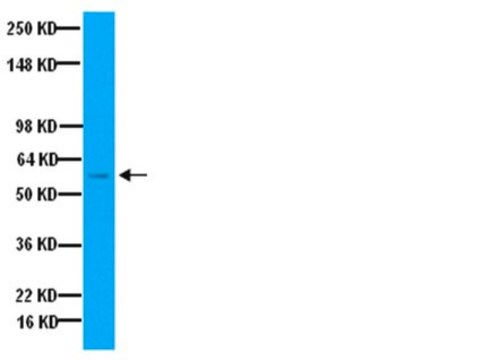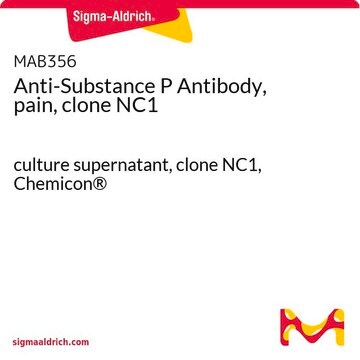ABN1380
Anti-Caspr2 Antibody, extracellular domain
serum, from rabbit
Synonym(e):
Contactin-associated protein-like 2, Cell recognition molecule Caspr2
About This Item
Empfohlene Produkte
Biologische Quelle
rabbit
Qualitätsniveau
Antikörperform
serum
Antikörper-Produkttyp
primary antibodies
Klon
polyclonal
Speziesreaktivität
mouse
Speziesreaktivität (Voraussage durch Homologie)
human (based on 100% sequence homology)
Methode(n)
immunocytochemistry: suitable
western blot: suitable
NCBI-Hinterlegungsnummer
UniProt-Hinterlegungsnummer
Versandbedingung
ambient
Posttranslationale Modifikation Target
unmodified
Angaben zum Gen
human ... CNTNAP2(26047)
Allgemeine Beschreibung
Spezifität
Immunogen
Anwendung
Neurowissenschaft
Immunocytochemistry Analysis: A representative lot detected Caspr2 immunoreactivity at the juxtaparanodal region around the nodes of Ranvier by indirect immunofluorescent staining of teased fibers prepared from paraformaldehyde-fixed, desheathed wild-type, but not Caspr2-knockout, mouse sciatic nerves (Gordon, A., et al. (2015). Mol. Cell. Sci. In press).
Western Blotting Analysis: A representative lot detected a lower Caspr2 level in brain tissue lysates from mice with heterozygous Caspr2-knockout than wild-type mice, while no Caspr2 expression was detected in brain samples from mice with homozygous Caspr2-knockout (Gordon, A., et al. (2015). Mol. Cell. Sci. In press).
Qualität
Western Blotting Analysis (WB): A 1:5000 dilution of this antibody detected Caspr2 in 10 µg of mouse brain tissue lysate.
Zielbeschreibung
Physikalische Form
Lagerung und Haltbarkeit
Handling Recommendations: Upon receipt and prior to removing the cap, centrifuge the vial and gently mix the solution. Aliquot into microcentrifuge tubes and store at -20°C. Avoid repeated freeze/thaw cycles, which may damage IgG and affect product performance.
Sonstige Hinweise
Haftungsausschluss
Sie haben nicht das passende Produkt gefunden?
Probieren Sie unser Produkt-Auswahlhilfe. aus.
Lagerklassenschlüssel
12 - Non Combustible Liquids
WGK
WGK 1
Flammpunkt (°F)
Not applicable
Flammpunkt (°C)
Not applicable
Analysenzertifikate (COA)
Suchen Sie nach Analysenzertifikate (COA), indem Sie die Lot-/Chargennummer des Produkts eingeben. Lot- und Chargennummern sind auf dem Produktetikett hinter den Wörtern ‘Lot’ oder ‘Batch’ (Lot oder Charge) zu finden.
Besitzen Sie dieses Produkt bereits?
In der Dokumentenbibliothek finden Sie die Dokumentation zu den Produkten, die Sie kürzlich erworben haben.
Unser Team von Wissenschaftlern verfügt über Erfahrung in allen Forschungsbereichen einschließlich Life Science, Materialwissenschaften, chemischer Synthese, Chromatographie, Analytik und vielen mehr..
Setzen Sie sich mit dem technischen Dienst in Verbindung.








